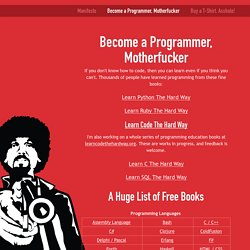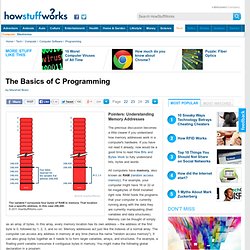

Invent Your Own Computer Games with Python - Chapters. Chapter 1 Read online: Chapter 1 - Installing Python Videos: Chapter 2 Read online: Chapter 2 - The Interactive Shell Chapter 3 Read online: Chapter 3 - Strings Download source: hello.py Copy source to clipboard: Use the online diff tool to find typos in your code: hello.py Chapter 4 Read online: Chapter 4 - Guess the Number Download source: guess.py Use the online diff tool to find typos in your code: guess.py Chapter 5 Read online: Chapter 5 - Jokes Download source: jokes.py Use the online diff tool to find typos in your code: jokes.py Chapter 6 Read online: Chapter 6 - Dragon Realm Download source: dragon.py Use the online diff tool to find typos in your code: dragon.py Chapter 7.

Become a Programmer, Motherfucker. If you don't know how to code, then you can learn even if you think you can't.

Thousands of people have learned programming from these fine books: Learn Python The Hard Way Learn Ruby The Hard Way Learn Code The Hard Way I'm also working on a whole series of programming education books at learncodethehardway.org. Learn C The Hard Way Learn SQL The Hard Way Learn Regex The Hard Way Graphics Programming Language Agnostic.
Linux Shell Scripting Tutorial - A Beginner's handbook. Programming Methodology - Download free content from Stanford. Codecademy Labs. The Basics of C Programming". The previous discussion becomes a little clearer if you understand how memory addresses work in a computer's hardware.

If you have not read it already, now would be a good time to read How Bits and Bytes Work to fully understand bits, bytes and words. All computers have memory, also known as RAM (random access memory). For example, your computer might have 16 or 32 or 64 megabytes of RAM installed right now. RAM holds the programs that your computer is currently running along with the data they are currently manipulating (their variables and data structures). Memory can be thought of simply as an array of bytes. Float f; This statement says, "Declare a location named f that can hold one floating point value. " While you think of the variable f, the computer thinks of a specific address in memory (for example, 248,440). F = 3.14; The compiler might translate that into, "Load the value 3.14 into memory location 248,440.
" The output that you see from the program will probably look like this: Learn C++